Storm: Frontline Nation Review
Nowadays, anyone familiar with video games should be aware of the main divide in strategy games: with the exception of a few unclassifiable hybrids, all strategy games can be sorted according to whether they are ‘turn-based’ or ‘real-time’. With the surge in processing power of home computers in the mid 90’s, came an increased focus on real-time strategy games - simultaneous action featuring multiple factions had much wider mass-market appeal than the board game pace of their turn-based counterparts.
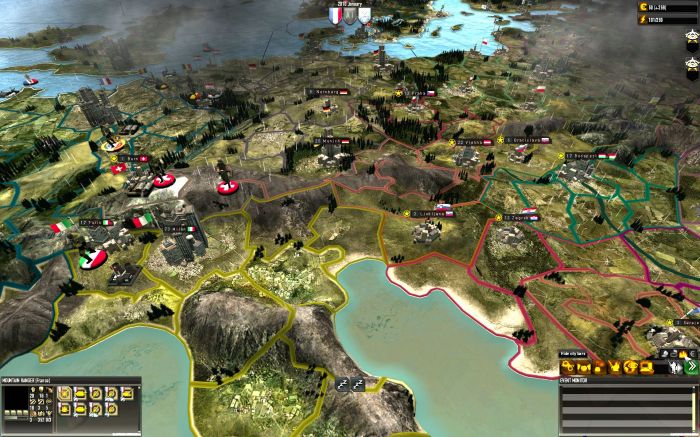
Since then, a number of titles - most notably the Total War series, have thought to combine the genres by utilising a turn-based world map to manoeuvre armies and manage the player’s empire, before switching to a real-time map of a territory for combat. ‘True’ turn-based games, on the other hand, would typically either concentrate on smaller ‘tactical’ gameplay, with units engaging in combat across a regular grid; or utilise a larger scale world map, with combat determined by statistical calculations and dice roles.
For those looking for to keep it strictly turn-based, comes STORM: Frontline Nation (yes, it should be capitalised; and no, it doesn’t appear to be an acrynom); one of the few games, to our knowledge, that combines a large scale world map with turn-based tactical combat.
Keeping the storyline bang up to date, the game is set in the very near future (specifically 2012); albeit taking a handful of minor liberties with recent history; following the 9/11 attacks, and the invasions of Afghanistan and Iraq, further terrorist attacks - involving both chemical and nuclear weapons, result in the invasion of Syria and Iran; the resulting disruption to oil supplies and bitter in-fighting leads to the collapse of the European Union.
Although the United States, China and assorted Middle Eastern states play significant roles in the back story, gameplay focuses on Europe and north Africa; the map extends as far east as Odessa, Kiev and Marsa Matruh, a small Egyptian town which serves as the starting location for US forces. All of the countries in the region (with the exception of principalities such as Monaco and Andorra) are present and playable, meaning any Gaddafi fans are more than welcome to try and exact virtual revenge on NATO countries.
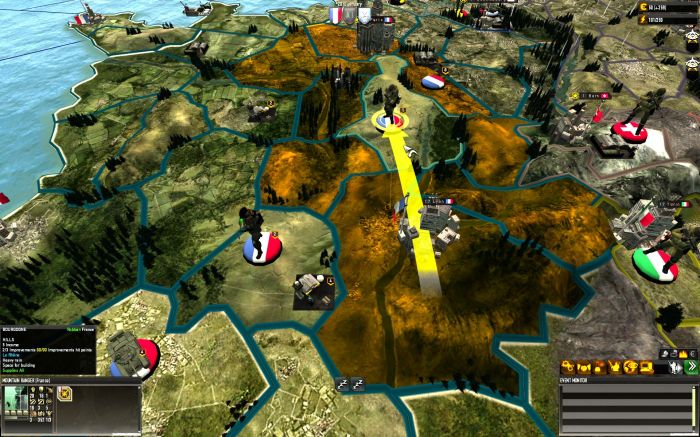
Obviously a solid back-story and an extensive roll-call of playable factions are nothing without decent gameplay to make everything worthwhile. Players looking for a bit of quick action can dive into the Skirmish mode; Skirmish focuses on the combat element and allows the player to fight a one-off battle on a randomised map. The real meat of the game however, comes in the form of the Campaign mode; with a further choice of Story and Open Campaign.
Selecting Story Campaign limits the player to a choice of five nations: France, Germany, Russia, UK and USA, each with their own short and long term goals. For example, Russia’s primary focus is to regain influence over the former Soviet states in eastern Europe; whilst the UK is concerned by a resurgence of terrorist activity linked to Irish Republicans. Alternatively, opting for Open Campaign allows you to select any of the playable nations, picking your allies and enemies as you see fit.
Throughout the campaign, the player is set missions. Occurring every 3/6/9 turns (depending on the frequency selected at the beginning of the campaign) and needing to be completed within a set number of turns, the task can vary from producing a set number of units to occupying specific territories. When playing a Story Campaign, additional Story missions are set, with the ultimate aim of being the first of the five nations to complete all of their Story missions.
In strategic mode (the world map), players are able to perform all the tasks you would expect - diplomacy, research, production etc., however the options within each of these areas are somewhat limited when compared to mainstream titles such as Civilization, let alone niche games like the Hearts of Iron series. Research, for example, is limited to multiple levels across five different areas: nuclear weapons, biological weapons, chemical weapons, missiles and the rather generic ‘technology’. Of these, technology is the most useful early on, as it grants access to additional kits and upgrades for military units, and affects Electronic Warfare during combat.
Countries will inevitably start attacking each other within a matter of turns, and it’s not surprising to see some of the smaller countries wiped out shortly after fighting begins. Egypt is typically the first to fall at the hands of the US; however as the Americans start with only a single territory and city, players selecting Egypt in Open Campaign mode can normally overpower them before they have a chance to expand.
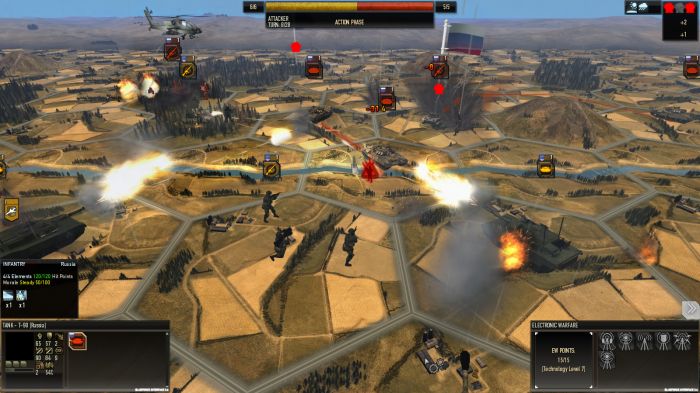
Once the player decides it’s time to send their military into action, or are unfortunate enough to have an enemy make that decision for them, then game play switches to the tactical mode for the purpose of combat. Battles take place on a randomly generated hex-map based on the terrain in the territory being contested; whilst it works the majority of the time, I did once encounter a bridge that couldn’t be crossed because the mountain tile adjacent to it couldn’t be climbed by any of my units (common sense would probably tell me that I should take some Mountain Troopers next time I’m assaulting mountainous regions).
Before combat beings, units must be deployed; regardless of how many units you’ve brought to the battle, you’re limited to 7 in play at any one time, with replacements available to deploy once a unit is eliminated. Orders are issued in turn, however executed simultaneously; so if you’ve targeted an enemy unit with your artillery, it’s always possible that the unit will move off the tile you’ve targeted when the shells actually start falling.
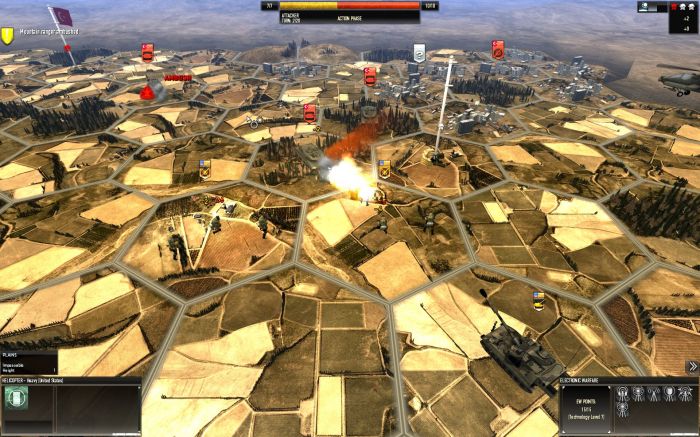
Victory in tactical mode is determined by eliminating all the enemy units or seizing all 3 control points on the map. Holding the control points also give Electronic Warfare points, that can be spent on various special powers that last a single turn; such as defensive or offensive bonuses, or preventing an enemy unit from moving. The maximum number of EW points is, as previously mentioned, determined by the technology research level.
In time, everything becomes fairly obvious and intuitive, however the game can be a little confusing when still learning the ropes - a fact not helped by the tutorial. In an age where we’re used to having tutorial levels guiding us through the main user interface and gameplay mechanics; the decision to have a series of 38 unvoiced videos demonstrating various aspects of the game does seem questionable. Whilst the tutorials are informative, it can be somewhat daunting being faced with all the topics to work through; although this is mostly just a by-product of being spoilt by hand-holding walkthroughs from larger developers.
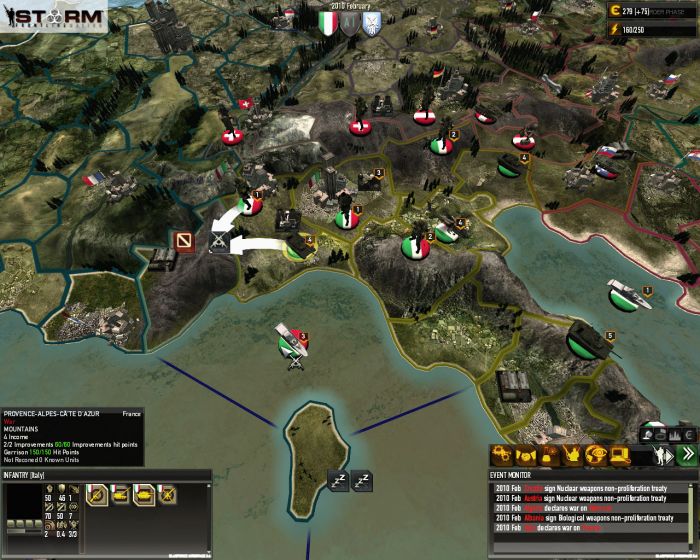
Other issues include the naval aspect of the game; there are numerous vessels available, however the focus is very much on transportation - transport ships carry ground units, aircraft carriers carry air units and submarines carry missiles. Naval units can engage in combat with each other but battles are resolved automatically, and there is no ability to bombard coastal areas. In addition, infantry units can be offloaded onto any coastal tiles, however armour units can only go ashore on tiles with cities or naval bases; it’s an obvious nod towards realism but very frustrating when trying to launch invasions, especially if playing as the UK.
Units, when selected, like to respond by telling you what they are; unfortunately with each unit only having one response, it does become rather repetitive - the infantry’s pronunciation being particularly grating. Obviously, not all games can be produced in a player’s home country, so someone is always going to find the voice work for any given game to be questionable, but it would have been nice for individual nations to have appropriate accents.
Some might complain that the game is too simplified or streamlined - it is certainly lacking numerous features when compared to expansive 4X titles like the aforementioned Civilization, and doesn’t have anywhere near as many statistics as the graphical spreadsheets that are the most in-depth hardcore strategy games. At the same time, there will be those that complain the game is unnecessarily complex, with elements that should be stripped out in order to focus on the core gameplay.
Luckily for these users, the strategy genre has plenty of other games, one of which is certain to fulfil whatever cravings they have at any given time; in the same way that the internet is guaranteed to have pornography to suit any and all possible desires. As a developer’s first title, STORM: Frontline Nation is a thoroughly competent and challenging game; and despite a few flaws and bugs, there’s nothing show-stopping that damages the long term enjoyment of the game.
Yes, it will confuse and frustrate many for the first hour or so, but give it time and you’ll find yourself rampaging across Europe with a huge grin on your face.
Storm: Frontline Nation (Reviewed on Windows)
This game is great, with minimal or no negatives.
Nowadays, anyone familiar with video games should be aware of the main divide in strategy games: with the exception of a few unclassifiable hybrids, all strategy games can be sorted according to whether they are ‘turn-based’ or ‘real-time’.








COMMENTS